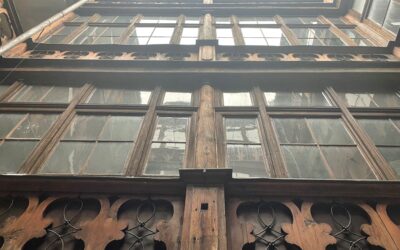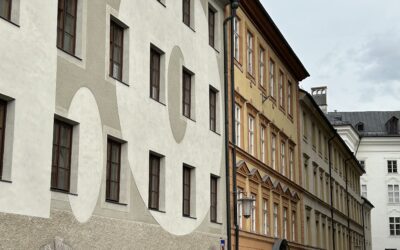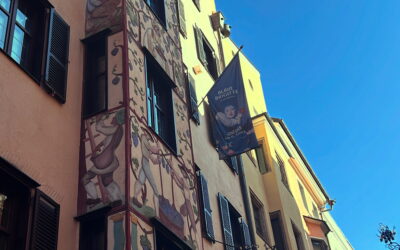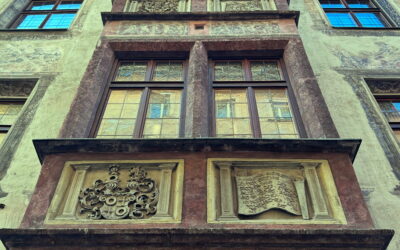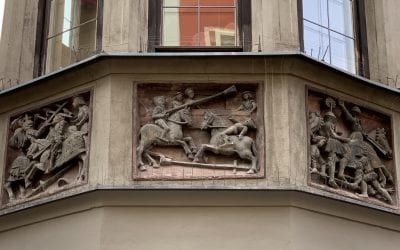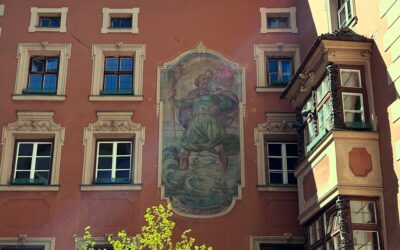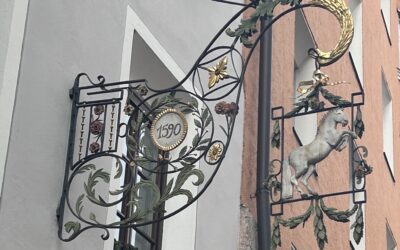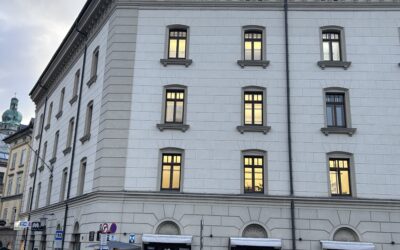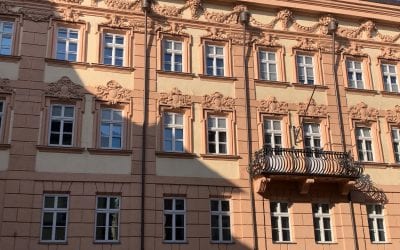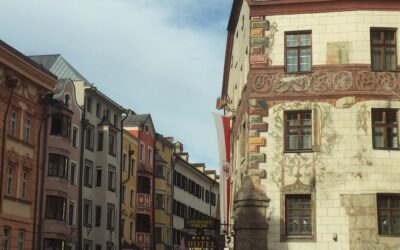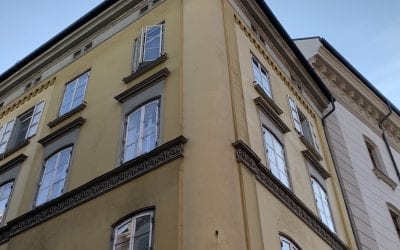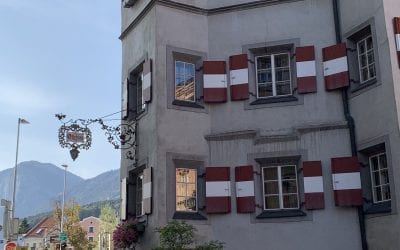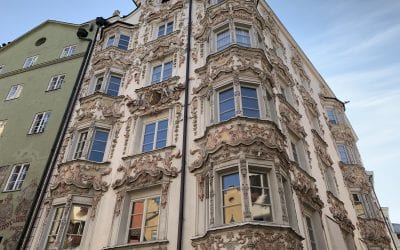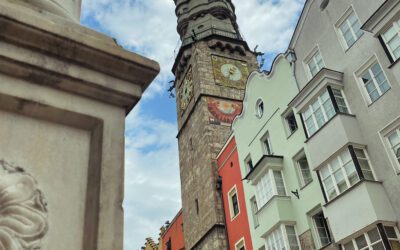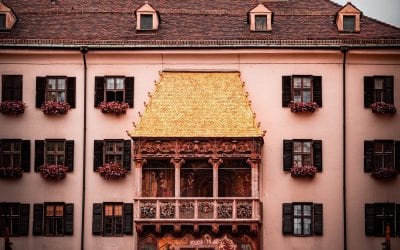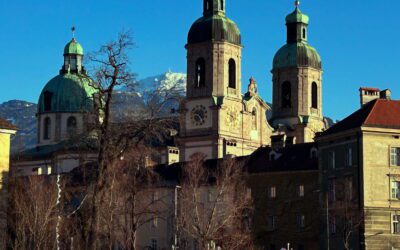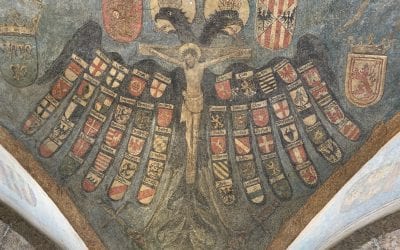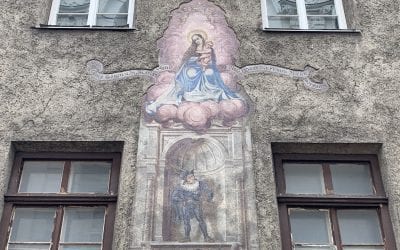Altstadt Innsbruck
Wissenswertes zur Altstadt Innsbruck
Flaniert man heute durch die Altstadt ist es kaum zu glauben, dass in dieser engen Fußgängerzone bis ins Jahr 1972 der Verkehr munter durchratterte. Man konnte mit dem Auto fast schnurgerade von der Brenner Bundesstraße bis zur Kettenbrücke fahren, um die Stadt nach Osten oder Westen wieder zu verlassen. Auf alten Fotos sieht man die Herzog-Friedrich-Straße randvoll zugeparkt. Verkehr als ein Übel anzusehen, ist ein recht junges Phänomen. Heute Horror und Schreckgespenst, war er von der Antike bis zur Massentauglichkeit des Automobils ein Hauptgrund für die Bedeutung und den Wohlstand Innsbrucks. Die Stadt, an der sich Wipp- und Inntal trafen, war auch schon vor dem Bau der Brennerautobahn ein Knotenpunkt Europas. Die Herzog-Friedrich-Straße lag an der Hauptverkehrsroute zwischen Venedig und Augsburg. Die im 19. Jahrhundert nach dem Tiroler Landesfürsten benannte Durchfahrt durch Innsbruck war im Mittelalter als Kramgasse bekannt, benannt nach den hier ansässigen Krämern, die zum großen Teil für den Wohlstand der Stadt verantwortlich waren. Im 15. Jahrhundert kam es zu großen Veränderungen innerhalb der Stadtmauern. Nach und nach wurden die Straßen gepflastert, um den Verkehr zu erleichtern. Wohlhabende Händler ließen die Laubengänge, genannt Chramen als erste Shoppingmeile der Stadt anlegen. Aus ihrem Stand bildeten sich die Kaufmannsdynastien heraus, aus denen sich das regierende Patriziat Innsbrucks bis hin zu Bürgermeister Wilhelm Greil speiste. Wo heute Touristenfallen ihren Tand anbieten, wurde jahrhundertelang nicht nur der lokale Handel, sondern vor allem der ertragreiche Fernhandel abgewickelt. Das Wappen der Firma Kolonialwaren Unterberger gegenüber dem Gasthof Weisses Kreuz zeugt bis heute von der Vergangenheit Innsbrucks als Teil einer der wichtigsten europäischen Handelsrouten. Die Fassadenmalereien, Schilder und Reliefs waren nicht nur Werbung für die Unternehmen, sondern dienten bis zur Nummerierung der Häuser im 18. Jahrhundert unter Maria-Theresia zur Orientierung. Der wirtschaftliche Aufschwung verhalf der Stadt auch zu mehr Hygiene und Komfort. Kleine Kanäle, die durch die Stadt führten, dienten der Abwasser- und Unratentsorgung. Das sollte nicht nur für saubere Gassen sorgen, sondern auch Krankheitserreger möglichst aus der Stadt schwemmen. Vor dem Dom kann man noch heute eine dieser Ritschn bewundern, die vor der Pflasterung um 1500 Innsbruck durchzogen. Auch in vergangenen Zeiten war den Menschen Sauberkeit und Wohlgeruch ein Anliegen. Für die Reinigung der Kanäle wurde vom Stadtrat der Totengräber bestimmt. Nachttöpfe der Stadtbewohner wie auch Tierfäkalien der Nutztiere wurden in den Inn gespült. Die Siedlungen flussabwärts östlich von Innsbruck kamen bis zur Regulierung des Inns häufig in den Genuss dieser exklusiven Mischung.
Auch am Hochbausektor veränderte sich in der Innsbrucker Renaissance einiges. 1340 wurden Holzaufbauten ohne Genehmigung des Stadtrates vom landesfürstlichen Gesetz verboten. Nach und nach verschwanden die alten Fachwerkhäuser. Die neuen, in Stein errichteten Häuser waren nicht nur wärmender und stattlicher als die vorhergegangenen Holzhäuser, sondern hatten auch den Vorteil weniger leicht Beute der Flammen zu. Der Kern vieler der bis heute bestehenden Gebäude reicht bis ins 15. und 16. Jahrhundert zurück. Sie wurden renoviert, ohne die gotische Struktur zu zerstören. Heute dank der liebevoll restaurierten Fassaden beliebte Sehenswürdigkeiten, waren es eigentlich reine Wohn- und Geschäftsgebäude. Die schmalen Gebäude zogen sich nach hinten in die Länge. Bei Kaufleuten befand sich im Erdgeschoß nach vorne hinaus der Verkaufsraum. Dahinter war der Steingaden, ein meist gemauerter Vorratsraum mit Keller. In den oberen Stockwerken der Steinhäuser waren die Wohnungen, eingeteilt in einzelne Stuben und Zimmer. In den Hinterhöfen befanden sich oft kleine Gärten oder gar Ställe. Zu verdanken ist die Modernisierung nicht nur dem Können der Baumeister, dem finanziellen Wohlstand durch den Handel und der Anziehungskraft der in der Stadt ansässigen Verwaltung und Aristokratie, sondern auch dem für Innsbruck charakteristischen Baumaterial. Es war die Höttinger Nagelfluhe, genannt Breccie, die nach den beiden großen Erdbeben von 1670 und 1689 viele der Bürgerhäuser verstärkte und festigte. Seit 1357 war es Bürgern der Stadt erlaubt, dass sie „They are allowed to cut, break and take tuft in all tuft pits they find and lead it to their city.“ Mit dieser Möglichkeit des günstigen Baumaterials förderte der Landesfürst die Modernisierung seiner Residenzstadt, ohne dafür selbst Mittel aufbringen zu müsssen. Brände, Erdbeben, Fliegerbomben – nichts konnte der Altstadt dauerhaft etwas anhaben. Während der Luftangriffe des zweiten Weltkrieges wurden nur das Winklerhaus und das Kapfererhaus und einige Gebäude in der Seilergasse mitgenommen. Der widerstandsfähigen Höttinger Breccie sei Dank.
Während die Errichtung der heutigen Altstadt am Aufstieg hing, ist ihre Konservierung dem Bedeutungsverlust Innsbrucks ab dem 17. Jahrhundert zu verdanken. Als 1665 mit Erzherzog Sigmund Franz der letzte Habsburger der Tiroler Linie kinderlos starb, wurde Tirol von Gubernatoren verwaltet. Innsbruck verlor seinen Status als Residenzstadt. Die Stadt blieb zwar das Zentrum des Landes und auch die Statthalter brachten ihren Hofstaat und Beamten mit, die Zeit privater Prestigebauten war aber fürs erste vorbei. Was für die Menschen damals wenig erbaulich war, ist aus heutiger Sicht ein Glücksfall: Die stadtbauliche Entwicklung stagnierte mit Ausnahme von Kirchenbauten außerhalb der mittelalterlichen Stadtmauern, was den frühneuzeitlichen gotischen Renaissance-Charakter der Altstadt bewahrte. Weichen mussten nur die alte Stadtmauer mit ihren Türmen und Stadttoren. Die neue Art mit schwerer Artillerie Krieg zu führen, machten die mittelalterlichen Verteidigungsanlagen obsolet. Die Umwidmung vom militärischen Zweck zum Wohnbau begann bereits Mitte des 16. Jahrhunderts. Die äußeren Gebäude der Altstadt bauen noch heute auf der alten Stadtmauer auf. Der letzte Wehrturm, der sogenannte Kräuterturm an der Nordwestecke am Herzog-Otto-Ufer, der auch als Stadtgefängnis diente, wurde 1890 abgerissen. Nur das Fundament des Kolbentums, der heute den Durchgang von der Herzog-Friedrich-Straße zur Schlossergasse bildet, blieb erhalten. Die Verzierungen im typischen Stil der Renaissance weisen noch auf die alten Strukturen hin. Direkt daneben befand sich bis weit ins 18. Jahrhundert das Vorstadttor. With the Pickentor, dem Inntor, dem Rumer Tor und dem Tränkertörl war es eines der fünf Stadttore. Heute erinnern nur noch Abbildungen an den ursprünglichen Standorten an die alten Eingänge Innsbrucks.
New Schoolhouse
Kiebachgasse 10
Old Schoolhouse
Domplatz 5
Gasthaus Weisses Kreuz
Herzog-Friedrich-Straße 31
Deutschordenshaus
Hofgasse 3
Katzung & Trautsonhaus & Weinhaus Happ
Herzog-Friedrich-Straße 14/ 16 / 22
Cafe Munding
Kiebachgasse 16 / Mundingplatz
Vier-Viecher-Eck
Ecke Kiebachgasse / Seilergasse
Andechsburg
Innrain 1
Claudiana – Altes Regierungsgebäude
Herzog-Friedrich-Straße 3
Gasthof Goldener Adler
Herzog-Friedrich-Straße 6
Ballhaus
Herzog-Friedrich-Straße 3
Ottoburg
Herzog-Friedrich-Straße 1
Helblinghaus
Herzog-Friedrich-Straße 10
Stadtturm & Altes Rathaus
Herzog-Friedrich-Straße 21
Goldenes Dachl
Herzog Friedrich Straße
Dom Sankt Jakob
Domplatz
Quaternionenadler
Herzog-Friedrich-Straße 35
Hofzwerg und Burgriese
Hofgasse 12
